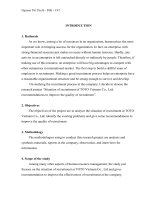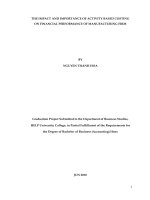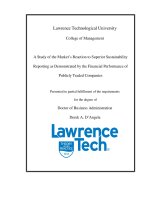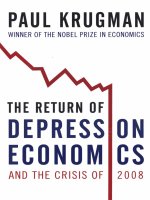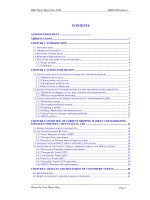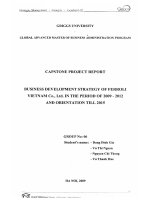Analyzing financial performance of united pharma vietnam co , ltd for a period of 2008 2009
Bạn đang xem bản rút gọn của tài liệu. Xem và tải ngay bản đầy đủ của tài liệu tại đây (673.37 KB, 83 trang )
TR
NG
IH CM
TP.HCM
UNIVERSITE LIBRE DE BRUXELLES
HO CHI MINH CITY OPEN UNIVERSITY
SOLVAY BRUSSELS SCHOOL
MBAVB
PHONG QUOC HOANG
ANALYZING FINANCIAL PERFORMANCE OF
UNITED PHARMA VIETNAM Co., Ltd. FOR A
PERIOD OF 2008-2009
PROJECT
MASTER IN BUSINESS ADMINISTRATION
(Part-time)
Ho Chi Minh City
2010
Name: Phong Quoc Hoang
Course: MBAVB1
DECLARATION
I hereby enclose eight hard copies of my final project “Analyzing Financial
Performance and Financial Position of United Pharma Vietnam for a period of
2008-2009” to Solvay Business School and Ho Chi Minh City Open University.
I confirm this final project is my own work. And I certify that all datas and
references using in this project are legal.
Name: Phong Quoc Hoang
Course: MBAVB1
ACKNOWLEDGEMENTS
I gratefully thank my Supervisor Dr. Nguyen Tan Binh for his valuable
advices and hearted guidance throughout the process of developing this study,
especially how empirical findings should be analyzed.
I would like to thank and appreciate Financial Division of United Pharm
Vietnam Co. Ltd. for great opportunity to work with them and for providing me with
access to internal record and data. With their kind help, I can optimize application to
this real case study. Special thanks to Mr. Renan Sabino Danganan for his
hospitality and readiness to support at all time.
Least but not last, I would like to acknowledge and thank to all professors, coordinators Mr. Serge and Ms. Tran and my classmates of MBAVB1 program who
have provided me with practical and helpful insights, comments and assistance.
Name: Phong Quoc Hoang
Course: MBAVB1
COMPANY’S COMMENTS
Mr. Hoang presented a detailed and in-depth analysis of the financial performance
of United Pharma Vietnam. He displayed a thorough knowledge of the financial
terms and concepts and was able to apply this in his analysis. We were impressed
with the details of his presentation, how he was able to go “deep down to the heart”
of our operation. He was able to present the financial information in a way that will
be useful to management in making strategic decision knowing full well the
relationship of the financial ratios with the financial performance. We appreciate
his practical suggestions and we sincerely thank him for this work.
Renan Sabino Danganan
Finance and Admin Director
Name: Phong Quoc Hoang
Course: MBAVB1
SUPERVISOR’S COMMENTS
Hoang applied a thorough knowledge of financial term and concepts to present a
detailed and in-depth analysis financial performance of United Pharma Vietnam.
He made great effort to collect data and benchmark financial ratios of Company
against those of its rivals. He was able to find out areas that need improvement and
proposed practical solutions.
Dr. NGUYEN TAN BINH
Name: Phong Quoc Hoang
Course: MBAVB1
TABLE OF CONTENTS
EXECUTIVE SUMMARY
CHAPTER 01: INTRODUCTION.......................................................................... 1
1.1 Problem Context ............................................................................................... 1
1.2. Objectives of Research Study ......................................................................... 2
1.3. Methodology.................................................................................................... 2
1.3.1. Research Approach .................................................................................... 2
1.3.2. Research Method ....................................................................................... 3
1.3.3. Data Collection .......................................................................................... 3
1.3.4. Limitation................................................................................................... 4
CHAPTER 02: LITERATURE REVIEW .............................................................. 5
2.1. Financial Statement Analysis .......................................................................... 5
2.1.1. Three Primary Business Activities ............................................................ 5
2.1.2. Users of Financial Statement ..................................................................... 6
2.1.3. Balance Sheet ............................................................................................ 6
2.1.4. Profit/Loss Statement ................................................................................ 7
2.1.5. Cash Flow Statement ................................................................................. 7
2.2. Financial Ratio Analysis of Financial Statement ............................................ 8
2.2.1. Interpretation of financial ratios ................................................................ 9
2.2.2. Liquidity Ratios ....................................................................................... 10
2.2.2.1. Current Ratio ...................................................................................... 10
2.2.2.2. Quick Ratio......................................................................................... 11
2.2.2.3. Cash Ratio .......................................................................................... 11
2.2.3. Profitability Ratios ................................................................................... 11
2.2.3.1 Net profit to Net sales Ratio................................................................ 12
2.2.3.2. Return on assets (ROA)...................................................................... 12
2.2.3.3. Return on equity (ROE) ..................................................................... 13
Name: Phong Quoc Hoang
Course: MBAVB1
2.2.4. Efficiency Ratios ..................................................................................... 13
2.2.4.1. Days Inventory Held (DIH)................................................................ 13
2.2.4.2. Days Sales Outstanding (DSO) .......................................................... 14
2.2.4.3. Days Payable Outstanding (DPO) ...................................................... 14
2.2.4.4. Cash Conversion Cycle ...................................................................... 15
2.2.4.5. Total Assets Turnover ........................................................................ 15
2.2.5. Leverage Ratios....................................................................................... 15
2.2.5.1. Debt to Assets Ratio ........................................................................... 16
2.2.5.2. Debt to Equity Ratio ........................................................................... 17
2.2.5.3. Interest Coverage Ratio ..................................................................... 17
CHAPTER 03: INFORMATION ABOUT COMPANY ....................................... 19
3.1. Company profile ............................................................................................ 19
3.2. Organization chart ......................................................................................... 20
3.3. Company’s Products ...................................................................................... 20
3.3.1. Consumer channel ................................................................................... 20
3.3.2. Pharmacy channel .................................................................................... 21
3.3.3. Medical Doctor Channel .......................................................................... 21
CHAPTER 04: ANALYSIS OF FINANCIAL PERFORMANCE FOR 02 YEARS
(2008 – 2009) ....................................................................................................... 22
4.1. Analyzing Business Performance for 2 Years (2008-2009) .......................... 22
4.2. Analyzing Assets and Source of Capital for 2 Years (2008-2009)................ 29
4.2.1. Analyzing Net Assets............................................................................... 29
4.2.2 Analyzing Total Assets ............................................................................. 30
4.2.3. Analyzing Sources of Capital .................................................................. 33
4.3. Cash Flow Analysis for 2 Years (2008-2009) ............................................... 37
4.4. Financial Analysis Through Financial Ratios ................................................ 40
4.4.1. Net Working capital ................................................................................. 40
4.4.2. Analyzing Liquidity Ratios ...................................................................... 40
Name: Phong Quoc Hoang
Course: MBAVB1
4.4.2.1. Current Ratio ...................................................................................... 40
4.4.2.2. Quick Ratio......................................................................................... 41
4.4.2.3. Cash Ratio .......................................................................................... 42
4.4.3. Analyzing Leverage Ratios ..................................................................... 42
4.4.3.1. Debt to Asset Ratio ............................................................................ 42
4.4.3.2. Debt to Equity Ratio ........................................................................... 43
4.4.3.3. Interest Coverage ratio ...................................................................... 43
4.4.4. Profitability ratios .................................................................................... 44
4.4.4.1. Net Profit to Net Sales Ratio .............................................................. 44
4.4.4.2. Return on Assets ................................................................................ 44
4.4.4.3. Return on equity ................................................................................. 45
4.4.5. Operational Efficiency ratios ................................................................... 45
4.4.5.1. Days Inventory Held (DIH)................................................................ 45
4.4.5.2. Days sales outstanding (DSO)............................................................ 46
4.4.5.3. Days Payable Outstanding (DPO) ...................................................... 47
4.4.5.4. Cash Conversion Cycle ...................................................................... 48
4.4.5.5. Assets Turnover Ratio ........................................................................ 48
4.4.5.6. Current Asset turnover ....................................................................... 49
4.4.5.7. Fixed assets ratio ................................................................................ 49
4.4.6. Analysis of Financial Ratios Across Pharmaceutical Companies ........... 50
CHAPTER 05: CONCLUSION AND SUGGESTIONS ....................................... 54
5.1. Conclusion ..................................................................................................... 54
5.1.1 United Pharma Vietnam - Year to Year Comparison............................... 54
5.1.2 United Pharma Vietnam vs Its Rivals ....................................................... 56
5.2. Suggestion ..................................................................................................... 57
Name: Phong Quoc Hoang
Course: MBAVB1
REFERNCES ........................................................................................................ 60
APPENDIXES ...................................................................................................... 61
Appendix 01: 2007-2009 Financial Statement of United Pharma Vietnam ...... 62
Appendix 02: 2009 Financial Statement of HauGiang Pharmaceutical ............ 66
Appendix 03: 2009 Financial Statement of Domesco Pharmaceutical ............. 68
Appendix 04: 2009 Financial Statement of Imexpharm Pharmaceutical .......... 70
Appendix 05: 2007-2009 Historical Exchange Rate – VND vs USD................ 72
Appendix 06: 2007-2009 Consumer Price Index............................................... 72
Name: Phong Quoc Hoang
Course: MBAVB1
EXECUTIVE SUMMARY
In financial perspective, to not only United Pharma Vietnam but also all
business entities, financial position and financial performance become important
to survival and development of today’s company. They have a two way
relationship where financial position and financial performance influence each
other.
Financial performance of United Pharma Vietnam for year 2008 and 2009
draw out two attentions. Firstly, its performance in 2008 was strong with growth
rate 22% for net sales and growth rate of 12% for net profit. Moving toward
2009, its performance was continuously improved with net sales increased by
26% and net profit increased by 57%. Total assets increased by 3% and 7% in
2008 and 2009 respectively. However, cash flow was deficit of VND 5.2 billion
and VND 1.5 billion in the same two periods respectively. Secondly, its
profitability ratios remained lowest compared to its rivals; specially in 2009, Net
profit ratio was 4%, ROA was 6% and ROE was 10% whereas intervals of those
ratios of studied Pharmaceutical Companies in VND showed Net profit to net
sales interval (4%, 21%), ROA interval (10%, 35%) and ROE (6%, 24%).
Therefore Management of United Pharma Vietnam wants to clearly understand
and address two following concerns:
1. How did its financial performance impact its financial position
2. How good was its financial performance and efficiency against its
rivals;
Hau
Giang
Pharmaceutical
Company
and
Domesco
Pharmaceutical Company and Imexpharm Pharmaceutical Company
Name: Phong Quoc Hoang
Course: MBAVB1
Based on the abovementioned reasons, I would like to propose my final
project “Analyzing financial performance of United Pharma Vietnam for a
period of 2008-2009”. Our analysis will primarily focus on the following areas:
• Company’s business activities
• Company’s financial performance and efficiency against its rivals in
perspective of financial ratios analysis
We hope that our final project can address the above concerns of
company’s management, and recommend the suitable solutions for improvement
for 2010 and 2011.
The analysis of final project is conducted primarily by analyzing the
historical data of financial statements of United Pharma Vietnam – Balance
Sheet, Profit/Loss Statement and Cash Flow Statement, and analyzing its
financial ratios. Furthermore, comparison of main financial ratios is made across
three above rivals.
Name: Phong Quoc Hoang
Course: MBAVB1
CHAPTER 01: INTRODUCTION
1.1 Problem Context
United Pharma Vietnam is a 100% foreign invested company. Currently its
scope of business is to manufacture and trade generic pharmaceutical products in
Vietnam market. Its capital was formed from owned capital and loan capital.
Financial Statement of United Pharma Vietnam for year 2008 and 2009
raised two concerns. Firstly, together with strong performance; sales growth of
22% in 2008 and 26% in 2009, net profit growth of 12% and 57% in 2008 and
2009 respectively, however cash flow suffered deficit of VND 5.2 billion and
VND 1.5 billion in the same two periods respectively. Secondly, pharmaceutical
sector was considered as high profitable rate in Vietnam due to strict compliance
and regulation to enter into this business, however
Company’s profitability
ratios were low; Net profit to net sales: 4%, ROA: 6% and ROE: 10%. Therefore
Management of United Pharma Vietnam wants to clearly understand and address
two following concerns:
1. How did its financial performance impact its financial position
2. How good were its financial performance and efficiency against its
rivals;
Hau
Giang
Pharmaceutical
Company
and
Domesco
Pharmaceutical Company and Imexpharm Pharmaceutical Company.
I believe that the existing topic “Analyzing financial performance and
financial position of United Pharma Vietnam for a period of 2008-2009” is more
meaningful to my final project and United Pharma Vietnam and it will encourage
me to go ahead with this research and interest Management of Company.
1
Name: Phong Quoc Hoang
Course: MBAVB1
1.2. Objectives of Research Study
In this project, I will focus my analysis toward the main following
objectives as follow:
• • Gain the depth understanding of financial statements and financial ratios
analysis.
• Provide company’s management with actual interaction of financial
position and financial performance of its company in financial perspective
for a period of 2008-2009
• Help the company’s management to understand its financial performance
and efficiency against its rival
• Find out areas that negatively influence its financial performance, and
propose solutions for improvement
1.3. Methodology
1.3.1. Research Approach
Basically, there are two broad research approaches: deductive and
inductive. Deductive approach begins with theory and work through observation
to find out results, inductive approach emphasis scientific principle and focus on
quantitative and valid data to explain casual relationship between variables of
financial statements and financial ratios.
In our research, we will start with description of important concepts such as
financial statement analysis and ratios analysis, subsequently collect data from
primary financial statements such as balance sheet, profit/loss statement and
cash flow, finally apply these important concepts to analyze and explain reason
2
Name: Phong Quoc Hoang
Course: MBAVB1
behind variances of financial statement and financial ratios. Therefore deductive
research is compatible for our research.
1.3.2. Research Method
In our final project, the basic methods that we use are horizontal, vertical,
trend based analysis, ratio analysis, factor analysis
Horizontal analysis is used to compute changes of individual articles of
financial statement in absolute value and percentage.
Vertical analysis is used to deal with proportion of individual articles in
total value of financial statements. An example, for cost of goods sold vertical
analysis by component will present percent of material cost, direct labor, factory
overhead to total cost of goods sold for a specific period.
Trend based analysis compares articles of financial statement or financial
ratios for several periods and reveal tendencies dominating in change of value.
Factor analysis reveal causes of changes in absolute and relative value
through decomposition of them
Ratio analysis studies levels and changes of relative measurements of
financial performance. Ratio analysis can help us tell how profitable a business
is, how the company is performing better this year than it was last year, how the
company is performing in comparison with other companies in the same business
sector… etc.
1.3.3. Data Collection
Data collection and quality of data are crucial to success of our research.
Data mainly comes from financial statement of company and financial ratios
index of other companies in its same business sectors such as Hau Giang,
3
Name: Phong Quoc Hoang
Course: MBAVB1
Domesco and Imexpharm. There are three main financial statements: Balance
Sheet, Profit/Loss Statement and Cash Flow.
1.3.4. Limitation
The study is limited to financial statement of United Pharma Vietnam
Company from 2007 to 2009 and financial ratios of Hau Giang Pharmaceutical
Company, Domesco Pharmaceutical Company and Imexpharm Pharmaceutical
Company. Financial ratios are computed mainly by weighted average method. I
am unable to obtain financial ratios benchmark of Vietnam Pharmaceutical
Industry to compare.
4
Name: Phong Quoc Hoang
Course: MBAVB1
CHAPTER 02: LITERATURE REVIEW
This section is to explain theoretical framework, which is used as a tool to
analyze our final project for empirical findings. Also theoretical framework will
help the readers to understand purpose of financial performance analysis as they
may have a little knowledge about it and help us to achieve objectives of our
final project.
2.1. Financial Statement Analysis
Three principal financial statements include balance sheet, profit/loss
statement, and cash flow. They are consolidated through accounting numbers and
provide useful information about the company’s performance, problems and
prospects. Also they have close relationship together.
Financial statement analysis is process by which analytical tools and
techniques are applied to financial statements to derive estimates and hints,
which is necessary to important business decision. Financial statement analysis
involves interpretation of accounting numbers shown in financial statement for
assessing the company’s performance, anticipating and planning future actions
for the company.
2.1.1. Three Primary Business Activities
Past financial performance and current financial position of company are
reported in its financial statements. Financial statements are designed to provide
information on three primary business activities, which consist of operating,
financing and investing activities. Analyzing financial statement help us to sort
out and evaluate information, and focus our intention on reliable information
most relevant to our business decision
5
Name: Phong Quoc Hoang
Course: MBAVB1
2.1.2. Users of Financial Statement
There are different users of financial statement, Shareholders and creditor
use it to assess past financial performance, current financial position and future
company prospects for investing and lending decision. Board of director uses
financial statement information to monitor management’s decision. Suppliers use
it to establish suppliers. Customers use it to decide whether to establish supplier
relationship. Auditors use it to assess fair presentation of its client’s financial
statement numbers…etc
2.1.3. Balance Sheet
Balance sheet summarizes a financial position of company and represents
the total value of all existing assets owned by the company, and the funding
sources of those assets at a point in time. The basic equitation is used for the
financial reporting system as follow:
Total assets = liabilities + owner’s equity
The left hand side of the equitation is assets and refers the economic
resources controlled by company. These resources are valuable in presenting
potential resources of future revenue through operating activities. Assets are
composed of current assets and non-current assets. Current assets, which is
expected to turn into cash within a year from balance sheet date, mainly
comprises cash, short term investment, inventory, receivable, advance, short
term deposits, prepaid expenses. In contrast, Non-current assets, which is not
expected turn into cash within a year from balance sheet date and not easy to
convert to cash, mainly comprises fixed assets, leasehold improvement, long
term repayment, long term investment, long term collateral and deposit.
6
Name: Phong Quoc Hoang
Course: MBAVB1
To engage in operating activities, the company needs to obtain funding to
invest in assets. The right hand side of this equitation identifies funding
resources. Liabilities are funding from creditors and represent obligation of the
company. Liabilities are divided into current liabilities and long term liabilities.
Current liabilities are expected to pay within a year from balance sheet date
whereas long term liabilities are not. Owner’s equity is total of funding invested
by shareholders and accumulated retained earnings.
2.1.4. Profit/Loss Statement
Profit/Loss statement provides information about a company’s operating
activities. Net profit of a company is equal to its net sales minus expenses; sales
arise from selling goods or service, and expenses measure the cost associated
with generating these sales.
Net profit will show the increase in net worth of company before
considering distribution to shareholders and contribution from shareholders, and
net loss will do inversely. In United Pharma Vietnam, net profit/loss is
determined by using accrual based accounting. Under this method, sales are
recognized when the company sells goods or renders services, independent of
receiving cash. In turn, expenses are recognized when related revenue is
recorded, independent of paying cash.
2.1.5. Cash Flow Statement
A cash flow statement is a financial report which reflects cash inflow and
cash outflow relating to company’s operating, investing and financing activities
during a reporting period. Cash flow enables the users to evaluate the company’s
ability to generate cash, determine their assets movement, perform liquidity and
7
Name: Phong Quoc Hoang
Course: MBAVB1
cash flow forecasting for subsequent period. Cash flow statement is structured in
three main parts: Cash flow from operating activities, Cash flow from investing
activities, Cash flow from financing activities.
Cash flow from operating activities which reflect total cash inflow and
outflow directly related to operating activities of the company such as: sales,
receivables, inventory, expenses paid to employees, suppliers, …ect.
Cash flow from investing activities which reflect total cash inflow and
outflow directly related to investing activities of the company. Its cash outflow
consists of amount invested in purchase of fixed assets and in other entities
through joint venture, shares or loan. Its cash inflow includes the gross amount of
cash received from disposal of fixed assets and from return on investment in
other entities.
Cash flow from financing activities which reflect total cash inflow and
outflow directly related to financing activities of the company. Financing
activities include those activities which relate to changing financial structure of
the company, such as capital contribution, loan, shares and loan repayment. It
cash inflow mainly includes the gross amount of cash received from loan receipt,
capital increase, share issuance. It cash outflow is mainly composed of amount of
cash used for interest payment, dividend payment.
2.2. Financial Ratio Analysis of Financial Statement
Financial ratios are useful by-product of financial statements and provide
standardized measures of a company’s profitability and risk. The most common
used tools of financial statement analysis are financial ratios. A ratio refers to
economically important relation. Ratio analysis involves methods of calculating
8
Name: Phong Quoc Hoang
Course: MBAVB1
and interpreting financial ratio in relative value. By which it helps us to measure
and evaluate company’s past financial performance and current financial
position.
There are different financial ratios as there are items appearing on balance
sheet, profit/loss statement and cash flow, and their application is defined from
the analyst point of view. The users apply various approaches depending on the
goal of analysis and business issues. Despite of number of ratios, they all cohere
through their classification
In our final project, financial statement analysis of financial performance
and financial position will go along with four directions where financial ratios
can be categorized as follow:
• Liquidity
• Profitability
• Efficiency and turnover
• Financial leverage
There are several ratios revealing each of four directions of financial
performance and financial position, which will be more details in sections later.
2.2.1. Interpretation of financial ratios
Ratio analysis is not just calculation of given ratios. Ratios, alone, are not
sufficient enough to understand a company’s past financial performance and
current financial position, and forecast its future prospects. Most important is
interpretation of ratio value. However it is not easy to do this work and there is
not single correct value for ratio. Correct conclusion that the value of a particular
ratio is high and low depends on perspectives of the analyst and company’s
9
Name: Phong Quoc Hoang
Course: MBAVB1
strategy. A financial ratio is meaningful only when it is compared with standard,
benchmark, such as ratio trend, financial ratio of our rival, planned management
objectives and industry trend.
2.2.2. Liquidity Ratios
The liquidity ratios are used to measure company’s ability to satisfy its
short-term obligations as they come due. Liquidity also stands for ability of a
company to convert its assets into cash quickly and with lower costs as possible.
Such liquid assets are necessary to cover any financial emergencies and play as
a buffer in company’s operations.
2.2.2.1. Current Ratio
This ratio compares current assets (cash, inventory and account receivables
and other current assets) that will turn into cash within a year to current liabilities
that will be paid within a year. Calculation is as below:
Current Assets
Current Ratio =
Current Liabilities
A company with a low current ratio lacks liquidity. If it is less than 1,
current liability will exceed current assets and company’s liquidity will be
threatened. Financially, a high current ratio is a financially favorable condition,
because it indicates the ability to pay current liability from conversion of current
assets into cash. Operationally, a high current ratio tends to increase operating
freedom and reduce probability of paying bill difficulty
10
Name: Phong Quoc Hoang
Course: MBAVB1
2.2.2.2. Quick Ratio
Differences in structure of assets may require calculating the quick ratio.
Some assets are more liquid then others are. Quick ratio is current assets minus
inventories, divided by current liabilities. Inventories are excluded in
computation of this ratio as it is the least liquid of all current assets.
Cash + Securities + Receivables
Quick Ratio =
Current Liabilities
A company with a low quick ratio lacks liquidity. Financially, a high quick
ratio allows the company little dependence on salability of inventories to meet
current obligations. Operationally, this high ratio tends to increase operating
freedom for company.
2.2.2.3. Cash Ratio
Cash Ratio (Absolute liquidity ratio). The most liquid assets are the
company’s cash and financial instruments. These assets have an absolute
liquidity and allow redeeming all obligations in time.
Cash + Cash Equivalent
Cash Ratio =
Current Liabilities
2.2.3. Profitability Ratios
Profitability ratios help to measure how well a company is managing its
expense and resources to generate profit. These ratios allow examine the
company’s profitability in relative to sales, assets and owner’s investment. These
11
Name: Phong Quoc Hoang
Course: MBAVB1
ratios are usually created by relating net profit to the resources utilized in
generating that profit.
2.2.3.1 Net profit to Net sales Ratio
This ratio measures net profit earned per a VND of sales generated by
company. It is calculated as follow:
Total Net Profit
Net profit Ratio =
Total Net Sales
The higher this ratio is the better it is for a company. If net profit margin
ratio is negative, a company incurs loss. In this case, a company must look at its
pricing structure, cost of goods sold, selling and marketing expenses, general
administrative expenses to find out the possible room for improvement. This high
ratio will facilitate a company to expand business and improve its financial
position.
2.2.3.2. Return on assets (ROA)
It is a basic measure of the efficiency with which a company allocates and
manages its resources. It measures earnings generated per a VND of money
provided by owners and creditors
Total Net Profit
Return on assets =
Total assets
The higher this ratio is the better it is for a company. A company is efficient
if it can use adequate minimum resource of assets to generate its expected
12
Name: Phong Quoc Hoang
Course: MBAVB1
return. If its current resource of assets is redundant, its excessive assets should
be shifted to new investment to improve its ROA.
2.2.3.3. Return on equity (ROE)
It is a measure of the efficiency in which a company employs owners’
capital to generate earnings. It measure earnings generated per a VND of
invested equity capital
Total Net Profit
Return on equity =
Total Owner’s equity
2.2.4. Efficiency Ratios
This is another set of ratios estimate how efficiently a company uses its
working capital. Efficiency ratios measure the speed with which various accounts
are converted into sales or cash inflows or outflows. During the analysis of
financial statement, it is important to look beyond measures of liquidity and to
evaluate the efficiency of specific current accounts. Several ratios are available
from the real analysis practices for measuring the performance of the most
important elements of working capital: inventory, accounts receivable, and
account payable.
2.2.4.1. Days Inventory Held (DIH)
This ratio measures the average number of days it takes to sell inventory. It
is calculated by dividing the averaged inventory held by the average daily cost of
goods sold. For this analysis, the averaged inventory held was determined by
using the inventory balance at the beginning of the year plus the inventory
balance at end of the year and divide by two.
13
Name: Phong Quoc Hoang
Course: MBAVB1
Average Inventory
DIH =
x 365
Total Cost of Goods Sold
A low ratio will contribute to improving efficiency of utilization of
company’s capital and increase the current liquidity of the company.
2.2.4.2. Days Sales Outstanding (DSO)
This ratio measures how many days on average it takes the company to
collect the credit sales. It is calculated by dividing the average account
receivable by the average daily sales
Average Account Receivables
DSO =
x 365
Net Sales
The closer the DSO is to the credit term policies of the company, the closer
the receivables are to optimal level.
2.2.4.3. Days Payable Outstanding (DPO)
This ratio measures how long it takes the company to pay creditors for the
materials and services that the company purchased. This ratio is computed by
dividing the average account payable by the average daily cost of goods sold
Average Account Payables
DPO =
x 365
Total Cost of goods sold
The larger the days payable outstanding is the better it is if the company is
able to actually pay creditor at the date agreed in contract.
14

